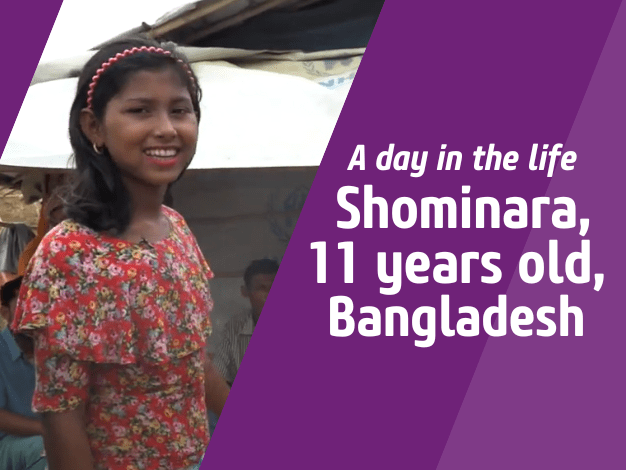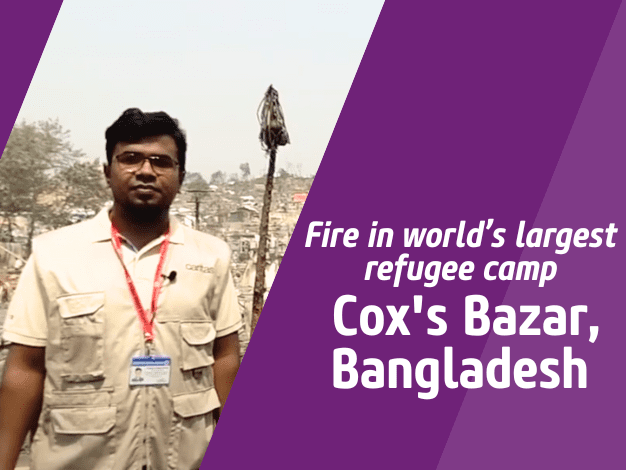Bangladesh, one of the poorest countries in the world, is a South Asian nation that is nearly completely bordered by India, except for a small border with Burma (Myanmar) in the extreme southeast (Chattogram Division). Characterized by great inequalities within its own population, Bangladesh has also seen its economic growth slowed by many recurring natural disasters. The country is regularly struck by cyclones, and each year, more than half of its territory is submerged by waters that destroy crops in the countryside, engulf homes and kill livestock. Cox’s Bazaar, a district in Chattogram Division, is among the most vulnerable to monsoon cyclones and has localized pockets of extreme poverty.
Between August 2017 and August 2018, over 830,000 Rohingya people in neighboring Myanmar fled persecution by state armed forces. They took the perilous journey to Bangladesh, raising the number of refugees there to almost 1 million. Many of these refugees were settled into temporary camps around Cox’s Bazaar. Children in these camps face serious risks that necessitate protection, including neglect, abuse, child marriage, child labor and trafficking. Girls are particularly susceptible to early or forced marriage and sexual abuse, whilst boys face heightened risks of child labor, exploitation and human trafficking.
The refugees have remained there for the past five years, dependent on humanitarian aid. Given that their acceptance and official status in Bangladesh is temporary and given political events in Myanmar including the military coup d’état in 2021, there seems to be no durable solution in sight for the Rohingya. The lives and livelihoods of Bangladeshi host communities are greatly impacted by the crisis, as they compete with the refugees over scarce resources and labor.


Development and Peace ― Caritas Canada’s local partner was one of the first humanitarian actors to respond to the Rohingya crisis in 2017 and has been continuously responding to the emergency needs of Rohingya refugees since then. Makeshift shelters were replaced with semi-permanent structures designed, in line with the refugees’ recommendations, to be more comfortable, durable, and weather-resistant. A comprehensive response was also designed to help the most vulnerable Bangladeshi host families, particularly women-headed households, enter the labour market through a combination of cash-for-work initiatives; agriculture and home gardening training; and training and support for small business development. In addition to increasing household food production, nutrition, and income, these activities helped restore the damaged environment, build confidence, and foster solidarity between the refugee and host communities.
With funding from Global Affairs Canada and support from us, our partner is providing shelter materials and training to the refugees. This enables them to build more weather- and fire-resistant shelters that are better suited to the needs of vulnerable subgroups. E.g., with women’s needs in mind, shelters have better ventilation, more kitchen space, and more private bathing spaces. More even floors, ramps, handrails, and wider entryways also make shelters more accessible and user-friendly for persons living with handicaps. An inclusive approach places refugees at the focus of aid. It equips them to better cope with future shocks while ensuring the sustainability, quality, and ownership of infrastructure.
With formal schooling not permitted beyond Grade 3 in the refugee camps, there are risks of being a “lost generation” of Rohingya children. To mitigate this risk, our partner provides a safe and supportive environment for learning in three multipurpose child and adolescent centers in the camps. These centers provide recreation and open play spaces for all children, provide early childhood education for 4- to 12-year-olds, and a life skills program for adolescents aged 12 to 18. Community members are trained to provide parental education on topics such as child rights, non-violence, peacebuilding, participation, and leadership to increase their capacity to respond to vulnerable children. They are also trained to detect distress and abuses and to ensure timely referral to services, especially mental health services for girls, boys, and caregivers.
Development and Peace ― Canada’s approach recognizes the continuous interconnection between emergencies and long-term development so that we can contribute to lasting change. We strive to achieve sustainable solutions and break the cycle of dependence on humanitarian assistance by enhancing resilience at the community level. Therefore, our response will continue to favor initiatives that serve as an initial step for longer-term community empowerment. This will be best achieved with strong local engagement and effective local partnerships and by supporting the capacities of local systems and structures through capacity building, coordination, and resource mobilization.




About us
Our work
Get involved
Ways to give
Resources
Get in touch
555 René-Lévesque Blvd. West, 8th Floor
Montreal (Quebec) Canada H2Z 1B1
Phone: 514-257-8711
Toll-free: 1-888-234-8533
Fax: 514-257-8497
Email: info@devp.org
Charity number: 1 1882 9902 RR 0001


Our international cooperation program is carried out in part with the financial support of the Government of Canada acting through Global Affairs Canada.
Development and Peace — Caritas Canada is the official international solidarity organization of the Catholic Church in Canada and the Canadian member of Caritas Internationalis.
Copyrights © 2024
Don’t miss anything about the work of our international partners or our awareness and mobilization campaigns.
Sign up now for our newsletter.